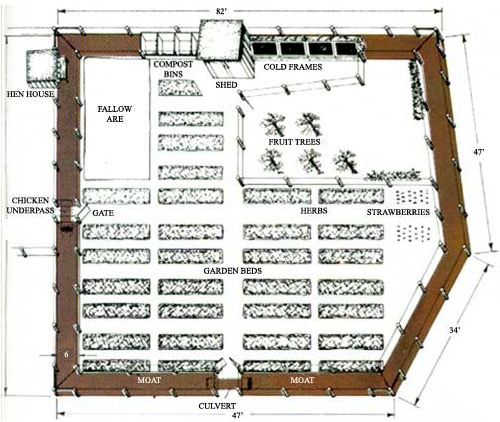We began our survival orchard by planting pecan trees.Why pecans? I'm glad you asked! I think nuts are really important survival foods because of their protein and fat content. We are at the northern most part of the country where pecans can survive, which violates my principle of choosing only trees that are unfailingly hardy in our area. Walnuts (among other nut trees) would have been a better choice.
Well, Hubby Dear detests walnuts and most other nuts besides pecans. As I needed his help planting and maintaining the trees, pecans it would have to be. Besides, I spent a couple of years of my life living in the midst of a pecan grove down in Louisiana and I have been a fan ever since of the graceful, productive pecan tree. We chose the most cold-hardy varieties we could find (Starking Hardy Giant, Stark Surecrop, and Colby) and are crossing our fingers that they like our chilly hilltop homestead.
 |
| How could I resist the opportunity to have my own mini pecan grove? Image from pawpaw.kysu.edu |
The other issue with pecan trees is that they take a long time to bear fruit. It can be anywhere from 5-12 years to get a crop of pecans and 20 years for a pecan tree to reach its full size (and they do get BIG). Pecan trees grown in containers tend to transplant better than bare-root trees and grafted pecan trees tend to produce nuts earlier, so keep that in mind if you're looking to add one or more of these fruitful giants to your landscape. And don't make the mistake that we did. We procrastinated and did not place our order for special "Select" pecan trees from Stark Bros. until they had already been for sale for two weeks. By the time we placed our order, they were sold out of Select trees and we had to settle for the runts of the litter. Our procrastination cost us at least two additional years before we'll see nuts.
 |
| A view of the southwest corner of our property |
Pecan trees get large, but luckily we have lots of space to fill. They need to be about 40' apart and well away from any power lines. We selected this space at the southwest corner of our 5 acres. We decided to be responsible citizens for a change and call to get our utility lines marked before we planted the trees. Hubby Dear gave a very specific description of the area we would be digging in when he filled out the online form for One Call:
"DIG AREA WILL BE ON THE SOUTHWEST PORTION OF THE PROPERTY, IN AN 80 FT X 80 FT AREA FROM A LINE CONNECTING THE ELECTRICITY POLE TO THE SOUTH FENCE, GOING EAST."
Seems straightforward to me.
 |
| I'm glad to know my backyard is OK... |
Apparently not. This is what ended up getting marked - the area between our house and the chicken moat! Oh well. At least we were able to scavenge the flags the doofus left behind to mark the spots where we wanted to plant each tree.
We crossed our fingers that we wouldn't hit anything, marked out positions for the three trees and got to work. Thankfully we had gotten 3-1/2 inches of precipitation over the previous week and it served to loosen things up slightly.
 |
| See the line of demarcation between topsoil and clay? |
I have a long history of bemoaning our poor soil. I was surprised to find that this portion of our property actually has several inches of topsoil. This is MUCH better than in our backyard garden area. I was excited to find lots of earthworms as we dug.
 |
| One hole down... |
The goal is to get a hole that is roughly 2' across and 2' deep. We dug down to 18" pretty easily, but past that point the clay was impenetrable to our shovels. Oh well, it would just have to do!
We took the topsoil and the best bits of the clay and mixed it in a wheelbarrow with some peat moss and compost. We used this mixture to fill in the holes. The addition of peat moss and compost will help loosen things up a bit for the trees. The trees themselves were tiny and came in 4"x10" pots. By the time they grow enough that their root systems fill the hole we dug, they should be strong enough to contend with the unamended soil that surrounds the place they were planted. That's the theory, anyway!
 |
| Our teeny tiny Colby pecan tree. Don't be fooled by the much larger bamboo support stake! |
We tamped down the soil mix tightly around the tree, eliminating air pockets that could cause the tree to dry out and die. Then we watered, watered, watered. Pecan trees really need a lot of water but unfortunately, these trees are far away from any faucet or hose. I'm comforting myself by the thought that lugging 5 gallon buckets of water around all summer is sure to build up my biceps.
We used some of the most dense pieces of clay to create small berms around the planting site. They work nicely to keep water around the trees and prevent it from running off downhill before it can soak in.
 |
| Stark Surecrop Pecan Tree with Typar weedcloth circle and mulch |
The next step was to lay a circle of landscape fabric around each tree and cover it with several inches of mulch. This will help to retain soil moisture and make mowing and trimming easier.
 |
| The finished product. As you can tell, it took us all afternoon to complete the job. |
The final step was to place a tree guard
That's it! Hopefully the little trees will thrive and grace us with beauty, shade, and lots of pecans.

















